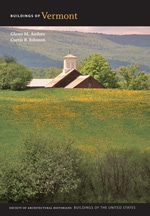
This two-story house is a good example of the persistence and adaptation of the classically detailed, central-hall plan house in the more isolated portions of rural Vermont. During the second half of the nineteenth century, Aaron C. Hitchcock, grandson of a town founder, amassed a three-hundred-and-twenty-acre sheep and dairy farm here on the upper Missisquoi River. He deeded the farm to his daughter after she and her husband, Hiram Miller, threatened to “go west,” and the Millers soon hired builder William Elkins to construct a new farmhouse. Elkins is credited with many local buildings including the Hitchcock Memorial Library (1899) next door, which Hitchcock donated to the town. A traditional gabled, central-hall design with entablatures and corner pilasters, the house rather awkwardly adopts Queen Anne features with its gable-end bay window, three-story polygonal corner tower, pent dormer over the main entrance, and originally a small entrance porch. In 1901, when the family moved in, they also moved the old Hitchcock homestead from its original location to a new foundation next door.

